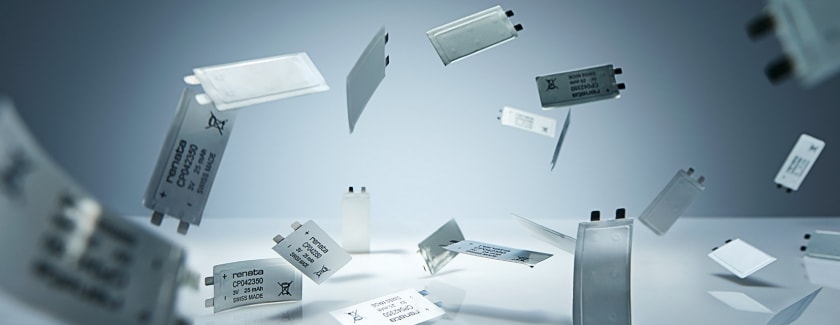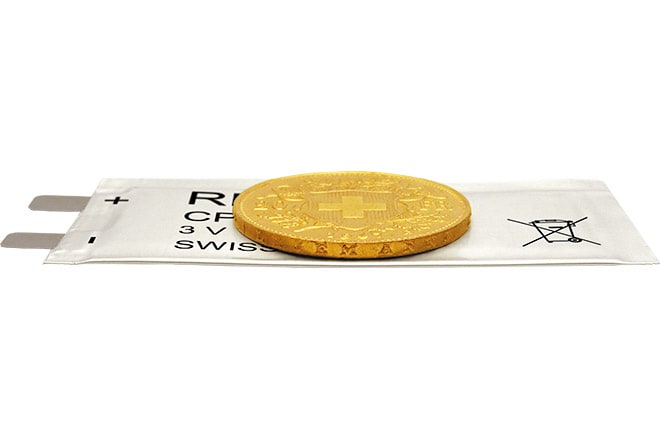Swatch steps in time with the beat

The biggest watch manufacturer supplies batteries for intelligent earbuds and other wearables.
The Swatch Group has already traveled further along the road to innovative portable energy than people realize. Granted, its subsidiary – Belenos – is focusing on batteries for electric vehicles and so has grabbed everyone's attention. But almost completely hidden away from the public eye, another of its subsidiaries – Renata – has been busy investing remarkable amounts in R&D. Renata has found a way to pack the correct amount of power into exactly the right form. As a result, new wearable devices are now becoming feasible. Stefan Pfrommer, the CEO of Renata, puts it like this: "Thanks to these batteries, our industrial customers are bringing a whole new generation of wearables to market." As an example, Pfrommer cites the intelligent earbuds that will be appearing in stores over the next few months, which are all down to Renata's new button cell batteries. "You'll be able to use them to make calls, get directions, or record and analyze physiological data for your own body." Within this context, it is as if wearables are continuing to seek out the best possible location on the human body. First came the wrist (smartwatches), then the eyes (Google Glass) – and now the focus is on the ears.
The search for the right location
Pfrommer explains this in the following terms: "Nowadays we carry all kinds of functions around with us in our smartphones – but it is not always practical to haul your phone out of your pocket: You might leave it somewhere, you might drop it." And that is why the industry is attempting to extract certain functions from the smartphone and move them to other parts of the body. The wrist is just one of many possible locations. Miniature processors and sensors can now be placed on new parts of the human body and powered cordlessly; from here, they can communicate wirelessly with other devices – innovations that are all down to Renata batteries.
Thanks to the new thin film batteries from Renata, miniature processors and sensors can even be packed into thin bands and – in turn – placed inside garments such as undershirts. Once here, the wearables are able to capture and analyze constant streams of data, such as the wearer's heart rate. In this way, they can detect signs of extreme stress, for example. "That's something else that we are going to see on the market," says Pfrommer. "Stress monitors that send a signal to a smartphone while also suggesting ways to counter the problem."
For instance, the wearer might receive a recommendation telling them that they should go on a half-hour walk or abstain from coffee for the rest of the day. It is obvious that Swatch has invested vast sums of money into R&D at Renata in order to achieve these technological successes. Pfrommer is not allowed to give us any figures, but: "What I can say is that the amount we invested in 2016 represents a multifold increase compared with what we were spending on research just five years ago." Wearables are regarded as a future market. And the Swatch Group is making sure it gets its slice of the pie. As part of this, Renata is building on the traditional strengths of the watchmaking industry, such as precision mechanics.
"For example, in Switzerland, we calibrate individual parts to an accuracy of thousandths; in China, accuracy is still only in the hundredths," says Pfrommer. Renata has taken these advantages, combined them with know-how about new materials and highly mature production techniques, and used them to create new batteries. What this means for consumers is that medical monitoring now slots conveniently into everyday life. Once upon a time, you went to the doctor or the hospital, where clunky medical equipment had to be wheeled over and you had to be hooked up to a machine via chest belts with suction cups. Now medical devices are shrinking. You can simply hide them away in your clothing like a strap or – as the industry hopes – people will think they are so stylish that they will want to show them off like earbuds. The idea in a nutshell: health monitoring integrated into consumer electronics.
Unresolved weakness of Smartwatches
In Pfrommer’s opinion, smartwatches have one fundamental weakness: They consume too much energy. "It's a problem that cannot be eliminated by having better batteries." His argument runs as follows: Most customers do not want to have to recharge their watch more than twice a year; otherwise, they will not be happy with it. However, that is simply not possible because of all the power-eating functions included in a smartwatch. Today's batteries can run a smartwatch for around 20 hours before they have to be recharged. Even if you could double this – an increase of 100% – you would still only end up with a running time of around 40 hours. This would require a technological miracle of moderate proportions and the customer would still not be satisfied. "Consider, for example, batteries for electric vehicles: In that context, an increase of just 30% within roughly the same amount of space would represent a major advance."
But also for Smartwatches Renata is part of the Swatch Group Innovation team working on its own operating system to eliminate this weakness.
(C) Schweiz am Sonntag / February 5th 2017 / NIKLAUS VONTOBEL


